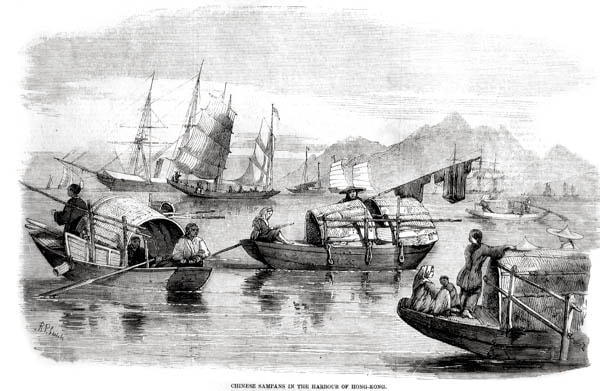The development of shipping and trade was disappointing at the beginning. In 1844, the first year in which any record of shipping entering the harbour was kept, 538 ships totalling 189,257 tons were recorded. The situation only improved slowly in the early years. For instance, in 1845, 672 ships totalling 226,998 tons entered the harbour. This rose to 700 ships totalling 228,818 tons in 1848, and 902 ships totalling 293,465 tons in 1849.[18] This could be attributed to a number of reasons, most significant of which being piracy, the illegal opium trade, salt smuggling, competition from other treaty ports, and the fact that no leading Chinese merchants would settle in Hong Kong as it was more advantageous to trade from Guangzhou.
According to a commentator in 1850, “ships came to Hong Kong from England merely to receive instructions from agents, land some house stores for the different shopkeepers, and to discharge a portion of their cargo which may not be immediately required in Canton, ultimately to find its way to Shanghai. Vessels from India arrive at Hong Kong for instructions only, and proceed up the river at once, or to an opium station some 40 miles from Hong Kong…Hong Kong has really no redeeming point at this moment. There is no inducement for the Chinese to bring produce there or to settle for the purpose of trade”.[19]
There were high hopes in the beginning that whilst western traders could only trade in the newly opened treaty ports, Hong Kong natives’ junks could trade anywhere. This would make Hong Kong the centre of the junk trade. However, to the disappointment of the colonial government, such a scenario was not realised as there was a Chinese clause in the Treaty of the Bogue forbidding such trade.[20]
The waters around the island of Hong Kong were infested with pirates. The most infamous of these were Chui A-po (徐亞保) and Shap Ng-chai (十五仔), who preyed on trading and fishing junks. Worse still, some European seamen occasionally joined the native pirates to plunder vessels. The leaders of the pirate fleets made Hong Kong their lairs, where native keepers of marine stores supplied them not only with arms and ammunition, but also with information on shipments of valuable cargoes as well as the movements of the police and British gunboats.[21]
Of the newly opened treaty ports, Shanghai proved to be the most successful. Located at the mouth of the Yangzi River, the most developed part of China, it soon became the centre of trade in eastern China.[22] Meanwhile, Guangzhou, with its solid foundation of foreign trade, continued to be the centre of trade in the south. It remained so until 1856, when the factories in Guangzhou were burnt to ground and the traders moved to Hong Kong.
Shipping grew substantially in the 1850s. In 1851, 1,082 ships of 377,084 tons entered the harbour, but the figures grew to 2,179 ships totalling 1,164,640 tons in 1859, apart from a temporary depression in 1857 caused by the hostilities between Britain and China during the Second Opium War.[23] The rise in shipping figures provides evidence of a phenomenal growth in trade. Apart from opium, amber, betel-nut, camphor, cotton, skins and furs, rice, soap, wine, woollen manufactures and more were imported, whilst exported items included, among other commodities, bamboo wares, china, pearls, furniture, ivory wares, lacquer wares, silk, tea, and firecrackers.[24] The marked improvement in shipping and trade was due to several reasons. First, the growth in local Chinese population increased native trade (the population grew to 86,941 in 1859). The unsettled conditions in the Pearl River Delta area caused by the Red Turban rebels led to an influx of wealthy Chinese families to Hong Kong, bringing with them the capital and expertise needed for the development of trade. The California Gold Rush of 1849 and the Gold Rush of 1851 in Australia brought a wave of Chinese emigrants to work in the gold fields overseas throughout the 1850s.[25] This was followed by the building of railways in North America. There was also a huge demand for Chinese labourers in South-East Asia and Latin America in tin-mining and rubber plantations. The growth in shipping in the late 1850s owed much to this profitable yet infamous coolie trade. The ill-treatment of the coolies on board ships attracted wide attention and generated criticism. Bowing to strong pressure, the colonial government passed a series of ordinances to rectify the situation. Subsequently, the coolie trade was moved to Macao and elsewhere.
Meanwhile, Chinese emigrating abroad still clung to their original way of life, and this led to a substantial trade in Chinese products through Hong Kong to overseas Chinese communities. Meanwhile, products from these countries were shipped to China through Hong Kong. The Nam Pak Hong (南北行) trade gradually developed.[26] The opening of Japan, Korea and Siam (Thailand) brought yet more opportunities for trade. The rise in shipping and the gradual establishment of Hong Kong as an entrepot in turn boosted ship building, ship-repairing, ship-chandling, godowns and wharves.
Notes:
- [18]
G. B. Endacott, An Eastern Entrepot: A Collection of Documents Illustrating the History of Hong Kong (London: Her Majesty’s Stationery Office, 1964), p. 132.
- [19]
T. N. Chiu, The Port of Hong Kong: A Survey of its Development (Hong Kong: Hong Kong University Press, 1973), p. 27.
- [20]
Endacott, An Eastern Entrepot, p. 100.
- [21]
G. B. Endacott, A History of Hong Kong (Hong Kong: Oxford University Press, 1964), pp. 131-132.
- [22]
Endacott, An Eastern Entrepot, p. xiii.
- [23]
Ibid., p. 132.
- [24]
Solomon Bard, Traders of Hong Kong: Some Foreign Merchant Houses, 1841-1899 (Hong Kong: Urban Council, 1993), p. 45.
- [25]
Endacott, An Eastern Entrepot, p. xii.
- [26]
Endacott, A History of Hong Kong, pp. 126-127.



